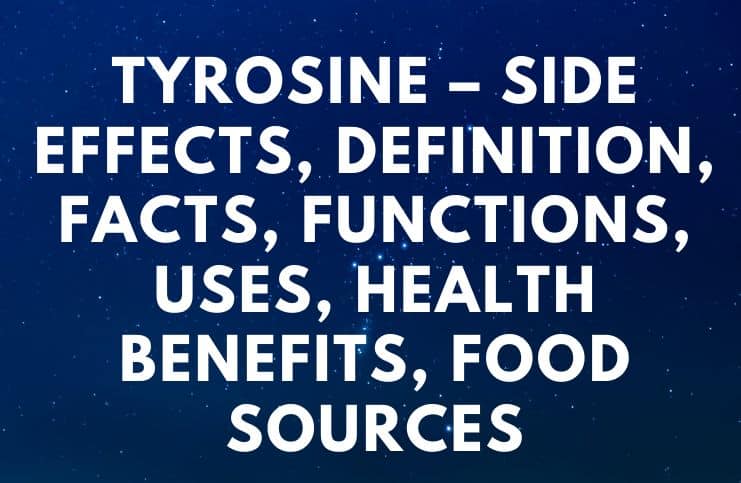Tyrosine – Side Effects, Definition, Facts, Functions, Uses, Health Benefits, Food Sources:
Facts
It is not an essential amino acid since it can be made from the amino acid phenylalanine (essential amino acid). It is additionally known by the chemical name of 4-hydroxyphenylalanine.
The word comes from the Greek and means cheese. This is in the quotation to the fact that this supplement was initially discovered from a cheese protein – casein, in 1846, by German chemist Justus von Liebig.
Uses and functions
This amino acid plays an important role in the fabrication of neurotransmitters norepinephrine and dopamine.
In addition, because this amino acid is necessary for the synthesis of thyroid hormone (which affects protein synthesis) and adrenaline (epinephrine), the amino acid supports healthy glandular function and stress response.
It is also an aromatic amino acid and is derived from the amino acid phenylalanine by hydroxylation in the para position. While this amino acid is hydrophobic, this non-essential amino acid is significantly more soluble than is phenylalanine.
The phenolic hydroxyl of it is significantly more acidic than the aliphatic hydroxyls of either threonine or serine, having a pKa of about 9.8 in polypeptides.
This amino acid contributes to the absorbance spectra of proteins and absorbs ultraviolet radiation.
Health Benefits
- it is effective at reducing stress levels;
- it is involved in the production and synthesis of extra chemicals and hormones such as Melanin;
- reduce blood pressure;
- improves alertness following the loss of sleep;
- it is needed to synthesize the benzoquinone structure, which forms part of coenzyme Q10.
Depression
In 2012, according to the NIMH, in the US, 16 million individuals had at least 1 depressive episode, plus, 1 in 20 young people aged 12-17 years had experienced a major depressive episode in 2014.
Taking supplements containing this amino acid may help some people in their fight against depression but in dosages above 500 mg/day.
Prevents neurodegenerative disorders
Parkinson’s disease develops from the loss of cells in the brain, which produces dopamine, a neurotransmitter that helps control the brain’s pleasure and reward centers as well as controls the body’s movements.
This condition affects up to one million people in the United States. Ingesting this amino acid may lower mood disorders, depression, Alzheimer’s disease, and in some cases, Parkinson’s disease.
Natural Remedy for ADH
Attention deficit disorder is a neurological and behavior-related disorder that causes impulsiveness, difficulty in concentrating, and excessive energy.
According to the CDC, attention deficit disorder diagnoses in children increased by about 41% between 2003 and 2011. Clinical trials of using supplements that contain this amino acid tried to improve ADH symptoms in patients showed some important positive results.
Food Source
It is found in a number of high-protein food sources. This includes meat, peanuts, almonds, hazelnuts, avocados, lima beans, white beans, adzuki beans, red kidney beans, chickpeas, lentils, milk, sesame seeds, chia seeds, flaxseeds, watermelon seeds, sunflower seeds, pumpkin seeds, bananas, mangoes, papayas, pineapples, apples, and soy products.
Side Effects of Tyrosine
The side effects can include overstimulation, restlessness, insomnia, and anxiety. Arrhythmias, rapid heartbeat, or heart palpitations are potential side effects that occur from high doses of this amino acid.
These can happen in sensitive individuals in as low a dose as 200 to 500 mg, or even less.
You would also need to avoid this supplement in combination with synthetic thyroid hormones and L-Dopa (typical Parkinson’s treatment).
There are not enough studies available to know if this amino acid is safe to use during pregnancy and breastfeeding.
Dosage
Clinical studies and research indicate that this non-essential amino acid can be consumed in amounts of up to 12 grams per day. Obviously, taking doses this high is not recommended except on the advice of a healthcare specialist.
The generally approved daily range seems to be between 1 and 5 grams. This may be partitioned into even administrations several times per day in order to maintain a constant supply in the body.
READ THIS NEXT:
Ornithine – Side Effects, Definition
Cysteine – Side Effects, Definition
Methionine – Definition, Facts, Functions
Alanine – Side Effects, Definition
References https://www.ncbi.nlm.nih.gov/books/NBK209061/ https://examine.com/supplements/l-tyrosine/
